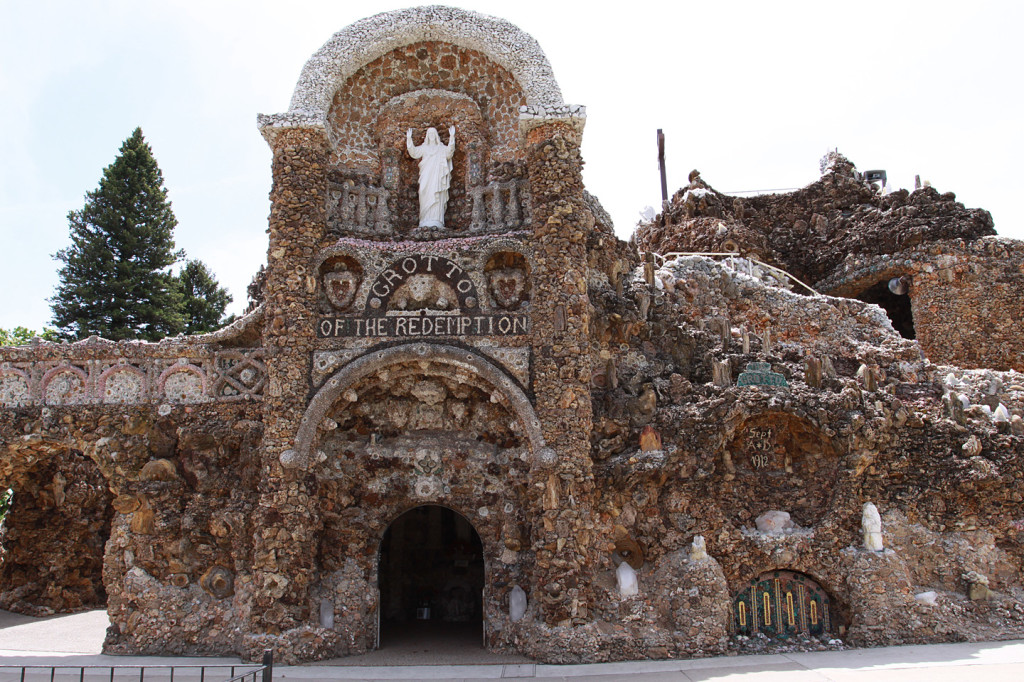
The Grotto of the Redemption is open 24 hours a day, seven days a week. A gift shop is open every day from 10 a.m. to 5 p.m. For a schedule of confessions, mass times and other details, visit www.westbendgrotto.com. Photos courtesy of the Grotto of the Redemption
By John Busbee
When religious calling meets creative muse and two such forces converge in a small part of northwest Iowa, the result is one of the most iconic destinations for solace, reflection and serenity in America — The Grotto of the Redemption.
Located in West Bend as part of the Roman Catholic Diocese of Sioux City, the Grotto of the Redemption has stood the test of time. It holds a special appeal as it is anchored by its nine grottos depicting scenes in the life of Jesus and is credited as being “the world’s most complete man-made collection of minerals, fossils, shells and petrifications in one place.”
A grotto can be a cave, or an artificial recess or structure made to resemble a natural cave. Mankind has used such structures for millennia, using them for modern, historic, prehistoric or religious purposes. Perhaps the most famous grotto is where Bernadette Soubirous experienced the apparitions of Our Lady of Lourdes in France. This site is a famous destination for Catholics and other visitors, and has inspired additional construction of Lourdes shrines throughout the world.
The origins for the Grotto of the Redemption rested in the vision and creative hands of Paul Matthias Dobberstein, a German immigrant born in Rosenfeld, Germany, on Sept. 21, 1872. His path to Iowa was long, filled with theological and architectural training and development before reaching what would be his final destination in West Bend, Iowa. Dobberstein’s education started at the University of Deutsch-Krone in German and continued at the St. Francis Seminary in St. Francis, Wis. In 1897, Dobberstein was ordained at St. Francis. His first assignment was at the Sisters of Mount Carmel hospital in Dubuque as its chaplain. About a year later, the Archdiocese of Dubuque was divided, and Dobberstein moved into the new Sioux City jurisdiction. He was appointed pastor of West Bend Saints Peter and Paul Catholic Church, where he served as counselor, instructor and leader for 57 years.
A pivotal crossroads in young seminarian Dobberstein’s life happened when he fell gravely ill with pneumonia. During his illness, he prayed to the Virgin Mary to intercede for him. If she answered his prayers, he promised to build a shrine of precious stones to honor her. He did recover, but the task that lay before him to make good on his promise was to be in West Bend. This was a region known more for agriculture than geology and precious stones, but he launched into the challenge. His long range strategy began with more than a decade of gathering material for what would become his magnus opus, the Grotto of the Redemption.
The early indications of Dobberstein’s artistry began to flourish while he was still in seminary. It was during his studies in seminary he built his first grotto, the Our Lady of Lourdes Grotto located in the Saint Francis de Sales Seminary’s wooded area. This seminary is located in the Milwaukee suburb by the same name, St. Francis. Through his career, he was the architect behind many famous religious grottoes. He designed and built Sacred Heart Church in Sioux City, Franciscan Convent in Dubuque, Catholic Cemetery in Wesley, John Brown Park in Humboldt and two creations that no longer exist: Immaculate Conception Grotto in Carroll and the Shrine in the St. Rose of Viterbo Convent of the Franciscan Sisters of Perpetual Adoration in La Crosse, Wis.
The Grotto of the Redemption would become what many claim is the largest grotto in the world. Construction began in 1912 and Dobberstein used those early years to collect precious stones from near and far as West Bend geology didn’t lend itself to an abundance of precious stones.
The glaciers blessed Iowa with rich silts and loam, one of the keys to its agricultural prowess. The Des Moines Lobe was the latest advance of the ice in Iowa and covered the region now known as Kossuth County. Also among the soils delivered by the glaciers were rocks. Through relationships with farmers and others around West Bend, Dobberstein was able to harvest those rocks from local fields. These rocks were a crop farmers really didn’t appreciate, but the visionary priest discovered an abundant local source to begin his quest that would last decades.
TO READ MORE ABOUT THIS STORY AND OTHER FASCINATING STORIES ABOUT IOWA HISTORY, subscribe to Iowa History Journal. You can also purchase back issues at the store.
